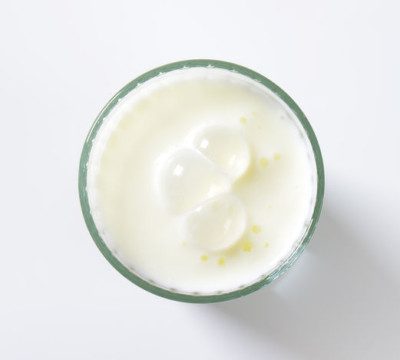Origin
Prior to industrialization, multiple milkings were needed before there was enough cream to churn into butter. Time and temperature allowed the naturally present bacteria in the cream to flourish and culture, resulting in a churned cultured butter and liquid cultured buttermilk.
With industrialization and introduction of refrigeration and pasteurization, processing improvements allowed for different types of this dairy product.
Function
Buttermilk is an important functional dairy product and can improve the nutrition, taste, appearance and texture of baked goods.
Sweet cream buttermilks are excellent emulsifiers due to their phospholipid level which is nine times higher than that of skim milk because of the way it’s processed. Phospholipids are excellent emulsifiers, but are associated with the health benefits of lowering cholesterol and blood pressure.2
Cultured buttermilk, like other fermented dairy products, has a pleasant piquant flavor that results from the added lactic acid bacteria. The bacteria convert some of the lactose in the milk to lactic acid. This acid creates the tangy taste and reacts with the sodium bicarbonate (baking soda) in recipes to produce carbon dioxide and leaven.
Composition and properties
In general, the composition of sweet and cultured buttermilk is similar to skim milk. It can have more fat because there is not a centrifugal process to remove fat like there is in skim milk production.1
The proteins in sweet cream buttermilk consist of approximately 80% typical milk proteins (casein and whey), while the remainder is the milk fat globule membrane that contain phospholipids.1 Proteins in milk products are nutritious and contain the essential amino acids that the human body needs.
Lactose, the sugar in milk products, has little sweetening power and is not fermented by yeast. Lactose, however, does caramelize and contribute to the brown crust color formation of baked goods.
Comparison of compositions3,4
| Component | Sweet cream buttermilk | Skim milk | Cultured buttermilk |
| Fat (g) | 0.6 | 0.09 | 0.5 |
| Protein(g) | 3.7 | 4.3 | 3.3 |
| Lactose (g) | 4.8 | 5.25 | 4.0 |
| Phospholipids(mg) | 78.6 | 8.5 | n/a |
| Lactic Acid (g) | trace | trace | 0.5-0.9 |
Commercial production
Sweet cream buttermilk is produced from pasteurized cream which is an oil and water emulsion. The emulsion breaks when cream is churned or passed through a continuous butter making machine. These processes break up fat globules and incorporate air that ultimately results in butter grains and buttermilk.
In contrast, cultured buttermilk is a pasteurized low fat or non-fat milk inoculated with mesophilic, homofermentative lactic acid bacteria. The result of culturing is:3
- Fats are now smaller chain, aromatic, flavorful fatty acids: acidic, butyric, propionic, valeric, caprylic, caproic and capric acids.
- Proteins (such as casein) are broken down to amino acids which enhance flavor.
- Vitamins/ Carotenoids are now simple vitamins B2, B6 and B12 which are readily absorbed.
Dry Buttermilk is defined by USDA standards and can be made by spray drying or the drum drying process. The powder must be derived from sweet buttermilk and pasteurized before condensing, and not from skim milk, whey or other products besides the sweet type.5
Application
Sweet and cultured buttermilk can improve the nutritional, function and sensory properties of baked goods. They improve moisture absorption, dough rheology, crumb and texture, browning and flavor. Nutritionally, these products contribute protein and mineral content.
The acid in cultured buttermilk reacts with baking soda to produce gas and leaven products. For this reason it can be an important ingredient in biscuits, scones, soda breads, quick breads, pancakes, waffles, muffins and cakes.
FDA regulations
On the ingredient label, cultured buttermilk is listed as “made from cultured skim milk” or “cultured buttermilk” and sweet cream buttermilk or dry sweet cream butter milk is listed as “buttermilk.” (21 C.F.R. § 101.4(b) (5 and 6) 2018).
The revised 2017 Pasteurized Milk Ordinance (PMO), defines it the “fluid product resulting from the manufacture of butter from milk or cream. It contains not less than 81⁄4 percent of milk solids not fat.”6
References
- Sodini, L, Morin, P, Olabi, A, Jimenez-Flores R. “Compositional and Functional Properties of Buttermilk: A Comparison Between Sweet, Sour and Whey Buttermilk”, J Dairy Sci, 89. 2006, pp 525-536.
- Conway, V, Gauthier, SF, Pouliot, Y. “Buttermilk: Much more than a source of Phospholipids”, Animal Frontiers. 2. 2014. pp 44-51.
- Kumar, R, Kaur, M, Garsa, AK, Shrivastava, B, Reddy, VP, Tyagi A. “Natural and Cultured Buttermilk”, Fermented Milk and Dairy Products. CRC Press, 2017, pp 207-215.
- Walstra, P, Jenness, R. Dairy Chemistry and Physics. John Wiley & Sons,1984, pp. 420-421.
- USDA AMS, Dry Buttermilk and Dry Buttermilk Product Grades and Standards. www.ams.usda.gov/grades-standards/dry-buttermilk-and-dry-buttermilk-product-grades-and-standards. Accessed on 25 Jan 2019.
- DHHS FDA. Pasteurized Milk Ordinance. 2017, ncims.org/wp-content/uploads/2018/06/2017-PMO-FINAL.pdf, Accessed on 14 Jan 2019.

